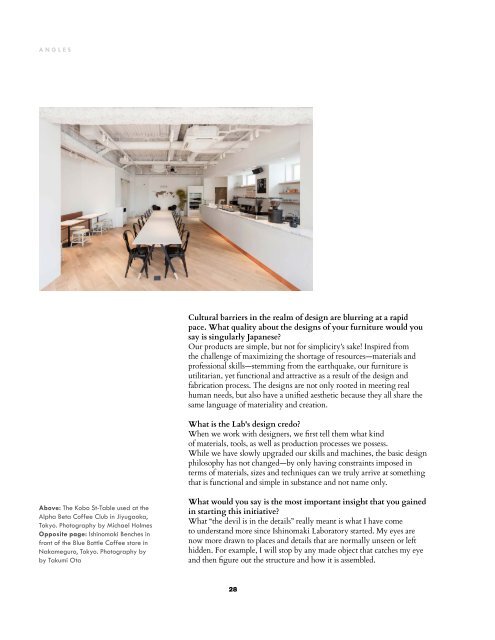Kanto Journal 3 Volume 2 2017
The Culture and Diaspora issue. A quarterly collaborative journal on architecture, photography, art and design, literature, food, and travel
The Culture and Diaspora issue. A quarterly collaborative journal on architecture, photography, art and design, literature, food, and travel
Create successful ePaper yourself
Turn your PDF publications into a flip-book with our unique Google optimized e-Paper software.
ANGLES<br />
Cultural barriers in the realm of design are blurring at a rapid<br />
pace. What quality about the designs of your furniture would you<br />
say is singularly Japanese?<br />
Our products are simple, but not for simplicity’s sake! Inspired from<br />
the challenge of maximizing the shortage of resources—materials and<br />
professional skills—stemming from the earthquake, our furniture is<br />
utilitarian, yet functional and attractive as a result of the design and<br />
fabrication process. The designs are not only rooted in meeting real<br />
human needs, but also have a unified aesthetic because they all share the<br />
same language of materiality and creation.<br />
What is the Lab's design credo?<br />
When we work with designers, we first tell them what kind<br />
of materials, tools, as well as production processes we possess.<br />
While we have slowly upgraded our skills and machines, the basic design<br />
philosophy has not changed—by only having constraints imposed in<br />
terms of materials, sizes and techniques can we truly arrive at something<br />
that is functional and simple in substance and not name only.<br />
Above: The Kobo St-Table used at the<br />
Alpha Beta Coffee Club in Jiyugaoka,<br />
Tokyo. Photography by Michael Holmes<br />
Opposite page: Ishinomaki Benches in<br />
front of the Blue Bottle Coffee store in<br />
Nakameguro, Tokyo. Photography by<br />
by Takumi Ota<br />
What would you say is the most important insight that you gained<br />
in starting this initiative?<br />
What “the devil is in the details” really meant is what I have come<br />
to understand more since Ishinomaki Laboratory started. My eyes are<br />
now more drawn to places and details that are normally unseen or left<br />
hidden. For example, I will stop by any made object that catches my eye<br />
and then figure out the structure and how it is assembled.<br />
28



